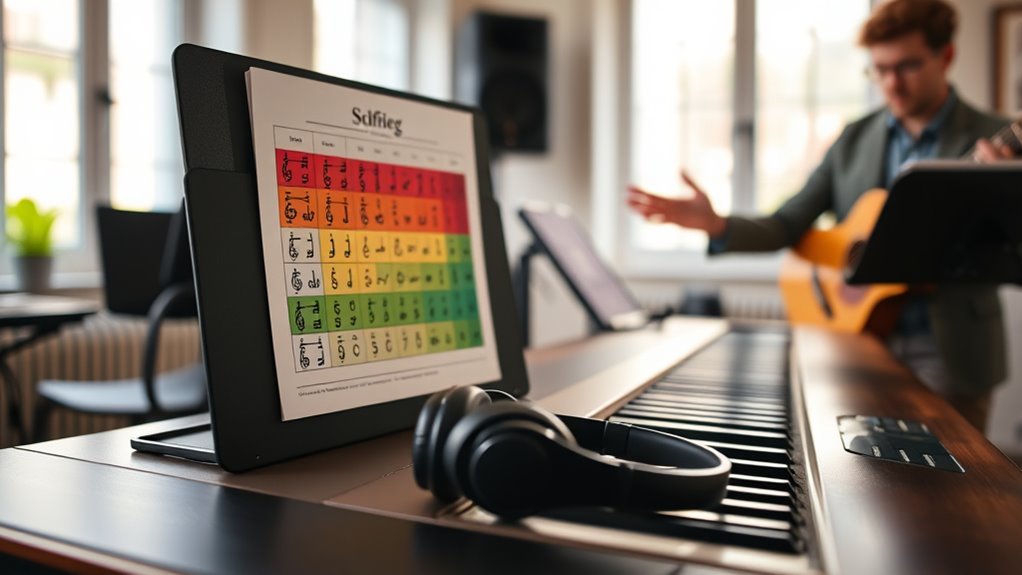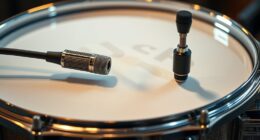Moving beyond fixed-Do helps you develop better relative pitch by focusing on interval recognition and pitch relationships rather than absolute pitches. By using movable-Do, you’ll learn to identify melodies and chords in any key, making transposing and improvising easier. Practice shifting the tonic, singing scales, and recognizing chord functions through intervals. This approach deepens your ear training, making you more flexible and accurate. Keep exploring, and you’ll discover how versatile and powerful movable-Do can be for your musical growth.
Key Takeaways
- Transition from Fixed-Do to Movable-Do enhances interval recognition and pitch function understanding across different keys.
- Practice scales and melodies starting on various pitches to internalize relationships and develop relative pitch skills.
- Focus on identifying the tonic and interval patterns instead of absolute pitches to improve transposition and harmonic awareness.
- Use active ear training exercises like melodic analysis, echo singing, and harmonic transcription to reinforce movable-do concepts.
- Regularly transpose melodies and chords in different keys to build flexibility, adaptability, and a deeper understanding of pitch relationships.
Understanding the Limitations of Fixed-Do Solfege

While fixed-Do solfege assigns specific syllables to each pitch regardless of key, this approach can limit your ability to recognize intervals and relationships across different tonal contexts. With fixed-Do, you develop strong absolute pitch, allowing you to identify pitches precisely. However, it may hinder your tonal memory—your capacity to understand how notes function within different keys. Relying solely on fixed syllables makes it harder to see how melodies adapt when transposed or played in varying tonal centers. This rigidity can restrict your ear training, especially when trying to recognize intervallic relationships and modulations. To truly improve, you need to move beyond fixed-Do, cultivating flexibility and a deeper understanding of pitch relationships that transcend specific syllables. Developing relative pitch skills enables singers and musicians to better adapt to changing tonal contexts and enhances overall musical comprehension.
The Foundations of Movable-Do Solfege

Understanding the basics of movable-do solfege helps you see how the system adapts to different keys and tonalities. You’ll learn how it connects to practical ear training and musical performance. Exploring effective teaching methods will give you tools to incorporate these concepts into your practice. A deeper understanding of personality assessment tools can also enhance your approach to teaching music by tailoring methods to individual learning styles.
Conceptual Overview
Movable-do solfege is a foundational system that assigns syllables to scale degrees, allowing you to identify pitches relative to a tonal center rather than fixed pitches. This approach enhances interval recognition and pitch matching by focusing on relationships between notes. When you hear a melody, you can determine its key and accurately match pitches without relying on absolute pitch. Understanding how syllables move through the scale helps you internalize the sound of intervals and develop a flexible ear. Here’s a visual overview: The importance of ear training in developing pitch accuracy and musical understanding is widely recognized among musicians and educators.
| Scale Degree | Syllable | Function |
|---|---|---|
| 1 | Do | Tonic (home pitch) |
| 2 | Re | Major second |
| 3 | Mi | Major third |
| 4 | Fa | Perfect fourth |
| 5 | Sol | Perfect fifth |
Practical Applications
Practicing movable-do solfege in real musical situations helps you develop a flexible ear and improve your pitch accuracy. By actively engaging with melodies, you sharpen your interval recognition skills, enabling you to identify relationships between notes more intuitively. This approach also enhances your ability to perform melodic dictation, as you learn to transcribe pitches by ear more accurately. When you apply movable-do in practice, you train your ear to see pitches relative to the tonic, making it easier to understand musical context. This real-world application bridges theory and performance, helping you internalize intervals and melodies naturally. Over time, you’ll notice increased confidence in improvisation, sight-reading, and identifying harmonic progressions, all rooted in a solid foundation of movable-do solfege techniques.
Pedagogical Strategies
Building a solid foundation in pedagogical strategies is key to effectively teaching and learning movable-do solfege. Focus on developing students’ interval recognition skills, which are vital for understanding pitch relationships and improving pitch accuracy. Use singing exercises that emphasize identifying and singing specific intervals, helping students internalize how different notes relate to each other. Incorporate visual aids, such as movable-do charts, and auditory activities like echo singing or call-and-response to reinforce pitch accuracy. Encourage students to actively analyze melodies, recognizing interval patterns and their sound qualities. Regular exposure to various instrumental and vocal sounds enhances students’ ability to distinguish pitches and intervals more accurately. Consistent practice with these strategies allows students to strengthen their ear, making it easier to identify pitches and intervals in real musical contexts. This approach builds a confident, intuitive sense of pitch and musical structure.
Transitioning From Fixed-Do to Movable-Do

Have you ever wondered how to smoothly shift your ear training from fixed-do to movable-do? Switching requires a few focused steps. First, visualize a scale with a moving tonic, like a lighthouse guiding your pitch. Next, practice interval recognition by comparing different sounds relative to this new center. Finally, work on pitch matching by singing or playing notes in relation to the tonic, reinforcing the idea that pitch depends on context, not fixed labels. By doing this, you’ll train your ear to identify intervals and match pitches more flexibly. Moving from fixed-do to movable-do enhances your ability to hear music in any key, making your ear more adaptable and accurate. This transition is key to developing true relative pitch.
Developing Relative Pitch Through Movable-Do

Developing relative pitch through movable-do involves actively training your ear to identify how intervals relate to the current tonal center. You do this by practicing pitch comparison, comparing different notes to the solfège syllable of the tonic. This process sharpens your interval recognition skills, allowing you to hear the distance between notes relative to the key you’re in. Instead of fixed pitches, you learn to recognize the quality and size of intervals based on their relationship to the tonal center. As you become more adept, you’ll intuitively identify whether a note is a step, a third, or a fifth away from the tonic, regardless of the key. This skill lays the foundation for more advanced ear training and musical understanding.
Applying Movable-Do to Scales and Chords

Now that you understand movable-do, it’s time to apply it to scales and chords. You’ll learn how to transpose scales accurately and identify chord functions within different keys. Using practical strategies, you can improve your ear for recognizing these elements in real music. Incorporating mindfulness and focused attention during practice can also enhance your ability to distinguish subtle tonal differences, making your ear training more effective. Mental focus can significantly improve your progress in mastering movable-do concepts.
Transposing Scales Effectively
Transposing scales effectively with Movable-Do involves understanding how to shift the tonic and maintain the correct interval relationships. Your goal is to keep the scale’s sound intact while changing its starting point. To do this:
- Visualize the scale’s intervals, like a pattern of steps and half-steps.
- Recognize the key’s new tonic point, ensuring you know where the scale begins.
- Apply interval recognition to preserve the relationships between notes, no matter the starting pitch.
- Keep in mind that interval accuracy is essential for maintaining the integrity of the scale during transposition.
This process enhances your scale transposition skills, making it easier to adapt melodies and chord progressions. You’ll develop a deeper understanding of how different keys relate and improve your overall ear training. Transposing with Movable-Do becomes a natural, intuitive part of your musical toolkit.
Recognizing Chord Functions
Understanding chord functions is essential for applying Movable-Do effectively because it helps you identify the harmonic roles of each chord within a key. By practicing interval recognition, you can determine the relationship between chords and their function, such as tonic, subdominant, or dominant. When you listen carefully, you’ll notice that certain intervals signal specific chord qualities, making chord identification easier. For example, recognizing a perfect fifth or major third can help you distinguish between major and minor chords. As you become more familiar with these interval patterns, you’ll intuitively grasp how chords function within progressions. This improves your overall ear training, allowing you to move beyond surface-level recognition and develop a deeper understanding of harmonic context.
Practical Application Strategies
To effectively apply Movable-Do to scales and chords, start by identifying the tonic note in any key and using it as a reference point. This anchors your interval recognition and enhances sight singing techniques. Visualize this process as:
- Pinpointing the tonic, like placing a flag on a map.
- Recognizing the intervals between notes, akin to measuring distances on a chart.
- Singing the scale or chord, imagining you’re traversing a path with clear landmarks.
- Remember that identifying the tonic is essential for accurate pitch and interval training, especially when practicing with different keys or unfamiliar material.
Practical Exercises for Moving Beyond Fixed-Do

Practicing beyond fixed-do involves actively shifting your focus from memorizing specific pitch names to developing a flexible sense of relative pitch. One effective exercise is interval recognition, where you identify the distance between two notes without relying on fixed pitch labels. Start by singing simple intervals, then progress to more complex ones, paying attention to their unique sound qualities. Melodic dictation is another valuable practice—listen to short melodies and transcribe them by ear, focusing on the intervals rather than absolute pitches. As you become more comfortable, challenge yourself with faster passages and varied harmonic contexts. Incorporating ear training exercises that emphasize developing your internal pitch relationships can further enhance your ability to move beyond fixed-do and develop a more versatile, intuitive ear.
Incorporating Movable-Do Into Your Daily Practice

Incorporating movable-do into your daily practice can substantially enhance your pitch awareness and flexibility. To do this effectively, focus on three key activities:
- Sing a scale starting on different pitches to improve interval recognition, hearing how intervals shift relative to the tonic.
- Practice pitch matching by listening to a note and reproducing it accurately, reinforcing your ear for precise pitch.
- Use solfege syllables to identify and sing melodies in different keys, strengthening your ability to adapt movable-do across tonal centers. This consistent approach helps you internalize the relationship between solfege and pitch, sharpening your ear for interval recognition and making you more confident in identifying melodies and harmonies on the fly.
Additionally, understanding the fundamentals of pitch and how movable-do functions across different keys can deepen your overall musical ear and adaptability.
Advancing Your Ear Training Skills With Flexible Solfege

Building on your foundation with movable-do, you can elevate your ear training by exploring flexible solfege techniques. These methods enhance your musical perception, allowing you to recognize intervals, chords, and melodies more intuitively. Flexible solfege helps you adapt to different keys and tonalities, making sight singing more accurate and confident. By focusing on the relationship between notes rather than fixed syllables, you develop a deeper understanding of pitch function. Practice shifting solfege patterns across various keys to strengthen your ability to identify intervals and melodies on sight. This approach not only broadens your musical perception but also improves your overall sight singing techniques, making you a more versatile and perceptive musician. Additionally, incorporating vetted methods such as movable-do can ensure your practice is both effective and aligned with proven training strategies.
Frequently Asked Questions
How Does Movable-Do Impact Sight-Reading Skills?
Movable-do considerably improves your sight-reading skills by enhancing interval recognition and pitch accuracy. When you use movable-do, you learn to identify pitches relative to a tonal center, making it easier to recognize intervals quickly. This approach helps you internalize pitch relationships, so you can read music more fluently. As a result, your overall sight-reading becomes more precise, and you develop a stronger sense of musical context.
Can Movable-Do Help With Improvisation Techniques?
You might find that movable-do enhances your improvisation skills by improving interval recognition and pitch flexibility. As you practice shifting do to different keys, you develop a better ear for pitch relationships, making it easier to create melodic variations on the spot. This adaptive approach helps you respond more intuitively during improvisation, giving you greater confidence and freedom to experiment with melodies and harmonies in real time.
What Challenges Might Beginners Face When Switching to Movable-Do?
Like learning to ride a bike, switching to movable-do can be tricky at first. You might struggle with developing your musical memory and pitch perception, which are essential for recognizing intervals and relationships. Beginners often find it hard to internalize the movable-do system, leading to confusion. However, with consistent practice, you’ll improve your ear, making it easier to adapt and see music in a new, more flexible way.
How Does Movable-Do Integrate With Modern Music Software?
Movable-do integrates seamlessly with modern music software, enhancing your musical flexibility and pitch perception. You can customize software to match different keys, allowing you to practice solfege in various tonal contexts. This adaptability helps you develop a more nuanced ear for pitch and harmony, making your ear training more practical and versatile. As you explore, you’ll find that movable-do encourages a deeper understanding of music theory and improves overall listening skills.
Are There Specific Genres That Benefit Most From Movable-Do Training?
You’ll find that genres like vocal jazz and contemporary pop benefit most from movable-do training. It helps you develop perfect pitch and relative pitch skills, making it easier to adapt to complex harmonies and melodic variations common in these styles. By training your ear with movable-do, you’ll quickly identify chords, intervals, and melodies across different keys, enhancing your improvisation, songwriting, and performance in these versatile genres.
Conclusion
By embracing movable-do, you’ll open new doors to ear training and musical understanding. It’s time to stop playing it by ear and start playing it with intention. Remember, Rome wasn’t built in a day, so be patient as you develop your relative pitch. Keep practicing consistently, and soon you’ll find yourself hearing music more clearly and confidently. With dedication, you’ll truly make the most of your musical journey—because practice makes perfect.










